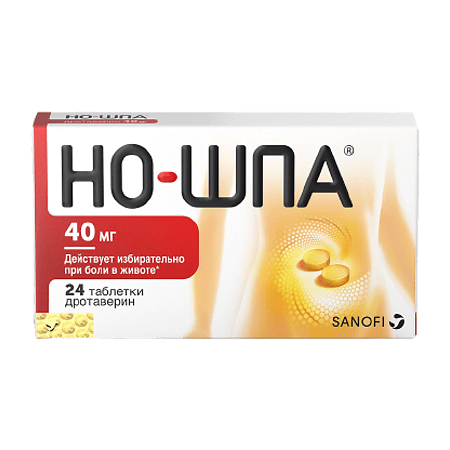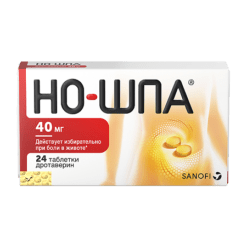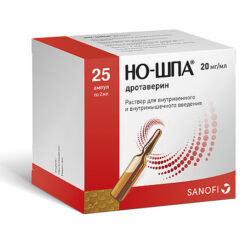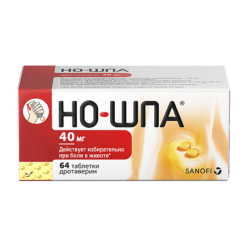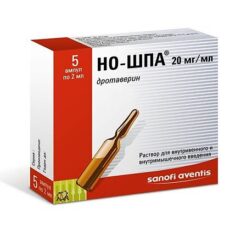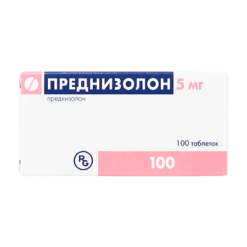No products in the cart.
No-shpa, 40 mg 24 pcs
€6.89 €5.03
Description
Drotaverine is an isoquinoline derivative that has a powerful antispasmodic effect on the smooth muscles by inhibiting the enzyme, phosphodiesterase (PDE). Phosphodiesterase enzyme is needed to hydrolyze cyclic adenosine monophosphate (cAMP) to adenosine monophosphate (AMP).
Inhibition of the enzyme phosphodiesterase leads to an increase in the concentration of cAMP; this triggers the following cascade reaction: high concentrations of cAMP activate cAMP-dependent phosphorylation of myosin light chain kinase (CLKM). Phosphorylation of CLSM decreases its affinity for the Ca2+-calmodulin complex, resulting in the inactivated form of CLSM supporting muscle relaxation. cAMP also affects cytosolic Ca2+ ion concentration by stimulating Ca2+ transport into the extracellular space and the sarcoplasmic reticulum. This downregulation of Ca2+ ion concentration by drotaverine via the cAMP explains the antagonistic effect of drotaverinate toward Ca2+.
In vitro, drotaverine inhibits the FDE IV isoenzyme without inhibiting the FDE III and FDEV isoenzymes. Therefore, the effectiveness of drotaverine depends on the concentration of FDE IV in tissues, the content of which varies from tissue to tissue. FDE IV is most important for inhibition of contractile activity of smooth muscles, therefore selective inhibition of FDE IV may be useful for treatment of hyperkinetic dyskinesias and various diseases accompanied by spastic state of the gastrointestinal tract.
The hydrolysis of CAMP in the myocardium and vascular smooth muscle occurs primarily via the FDE III isoenzyme, which explains the fact that with its high antispasmodic activity, drotaverine has no serious cardiovascular side effects and no pronounced cardiovascular effects.
Drotaverine is effective for smooth muscle spasms of both neurogenic and muscular origin. Regardless of the type of autonomic innervation, drotaverine relaxes the smooth muscles of the gastrointestinal tract, biliary tract, and urogenital system.
Pharmacokinetics
Absorption:
After oral administration, drotaverine is quickly and completely absorbed. After presystemic metabolism, 65% of the administered dose of drotaverine enters the systemic bloodstream. Maximum plasma concentration (Cmax) is reached after 45-60 minutes.
Distribution
In vitro drotaverine has high binding to plasma transactions (95-98%), especially to albumin γ and β-globumin.
Drotaverine is evenly distributed in tissues and penetrates smooth muscle cells. It does not penetrate the blood-brain barrier. Drotaverine and/or its metabolites may slightly penetrate through the placental barrier.
Metabolism
In humans, drotaverine is almost completely metabolized in the liver by O-deletion. Its metabolites rapidly conjugate to glucuronic acid. The main metabolite is, 4′-dezethyldrotaverine, in addition to which 6-dezethyldrotaverine and 4′-dezethyldrotaveraldine have been identified.
Exhaustion
In humans, a two-chamber mathematical model was used to estimate the pharmacokinetics of drotaverine. The final plasma radioactivity half-life was 16 hours.
Within 72 hours, drotaverine is almost completely eliminated from the body. More than 50% of drotaverine is excreted by the kidneys and about 30% through the gastrointestinal tract (excretion into the bile). Drotaverine is mainly excreted as metabolites, unchanged drotaverine is not detected in the urine.
Indications
Indications
Auxiliary therapy:
Active ingredient
Active ingredient
Composition
Composition
Active ingredient:
drotaverine hydrochloride – 40 mg;
excipients:
magnesium stearate – 3 mg,
talc – 4 mg,
povidone – 6 mg,
How to take, the dosage
How to take, the dosage
Adults
The average daily dose in adults is usually 120-240 mg (the daily dose is divided into 2-3 doses). The maximum single dose is 80 mg. The maximum daily dose is 240 mg.
Children
There have been no clinical studies with drotaverine in children.
In case of prescribing drotaverine in children:
– For children from 6 to 12 years of age, the maximum daily dose is 80 mg divided into 2 doses.
– for children over 12 years of age, the maximum daily dose is 160 mg divided into 2 to 4 doses. Duration of treatment without consulting a physician
When taking the drug without consulting a physician, the recommended duration of taking the drug is usually 1-2 days. If the pain syndrome does not decrease during this period, the patient should see a doctor to clarify the diagnosis and, if necessary, change the therapy. In cases where drotaverine is used as adjunctive therapy, the duration of treatment without consulting a doctor may be longer (2-3 days).
The efficacy evaluation method
If the patient can easily self-diagnose the symptoms of his disease because they are well known to him, the effectiveness of treatment, namely the disappearance of pain, is also easily assessed by the patient. If there is a moderate decrease in pain or, no decrease in pain within a few hours of taking the maximum daily dose, or if there is no significant decrease in pain after taking the maximum daily dose, it is recommended that a physician be consulted.
Interaction
Interaction
With levodopa
Papaverine-like phosphodiesterase inhibitors reduce the antiparkinsonian effects of levodopa. When drotaverine is administered simultaneously with levodopa, rigidity and tremor may be increased. With other antispasmodic agents, including m-cholinoblockers Mutual enhancement of antispasmodic effects.
Drugs significantly binding to plasma proteins (more than 80%)
Drotaverine significantly binds to plasma proteins, primarily albumin,
γ and β-globulin (see section “Pharmacokinetics”). There are no data on the interaction of drotaverine. with drugs that significantly bind to plasma proteins, but there is a hypothetical possibility of their interaction with drotaverine at the level of protein binding (displacement of one drug by another from protein binding and increased concentration of free fraction in blood of the drug with less strong protein binding), which hypothetically may increase the risk of pharmacodynamic and/or toxic side effects of this drug.
Special Instructions
Special Instructions
No-Spa® 40 mg tablets contain 52 mg of lactose. This may cause gastrointestinal complaints in persons with lactose intolerance. This form is not acceptable for patients with lactose deficiency, galactosemia or impaired glucose/galactose absorption syndrome.
Impact on the ability to drive and operate machinery
When taken orally in therapeutic doses, drotaverine has no effect on the ability to drive and perform work requiring increased attention. In case of any side effects the issue of driving and working with mechanisms requires individual consideration. In case of dizziness after taking the drug, potentially dangerous activities such as driving and working with mechanisms should be avoided.
Contraindications
Contraindications
With caution:
– In arterial hypotension.
– In children (insufficient clinical experience of use).
– In pregnant women.
Side effects
Side effects
The adverse reactions observed in clinical trials, divided by system, organ, and frequency according to the following gradations, are as follows: Very frequent (â¥10%), frequent (â¥1%, < 10); infrequent (â¥0.1%, < 1%); rare (â¥0.01%, < 0.1%) and very rare, including individual reports (< 0.01%), unknown frequency (frequency cannot be determined from available data).
Cardiovascular system disorders
Rare – palpitations, decreased blood pressure.
Nervous system disorders
Rare – headache, dizziness, insomnia.
Gastrointestinal tract disorders
Rare – nausea, constipation.
Immune system disorders
Rare – allergic reactions (angioedema, urticaria; rash, itching)
.
Overdose
Overdose
There are no data on overdose of the drug.
In case of overdose, patients should be under medical supervision and if necessary, they should be treated with symptomatic and aimed at maintaining basic body functions, including artificial inducement of vomiting or gastric lavage.
Pregnancy use
Pregnancy use
Similarities
Similarities
Additional information
| Shelf life | For tablets in blisters Aluminum/Aluminum: 5 years. For tablets in PVC/Aluminium blisters: 3 years. For tablets in bottles: 5 years. Do not use after the expiration date printed on the package. |
|---|---|
| Conditions of storage | For tablets in blisters Aluminum/Aluminum: Store at a temperature not exceeding 30 ° C. For tablets in PVC/aluminum blisters: store at a temperature not exceeding 25 ° C. For tablets in vials: store in a light-protected place at 15°C to 25°C. Keep out of reach of children. |
| Manufacturer | Opella Healthcare Hungary Ltd. |
| Medication form | pills |
| Brand | #Н/Д |
Other forms…
Related products
Buy No-shpa, 40 mg 24 pcs with delivery to USA, UK, Europe and over 120 other countries.

